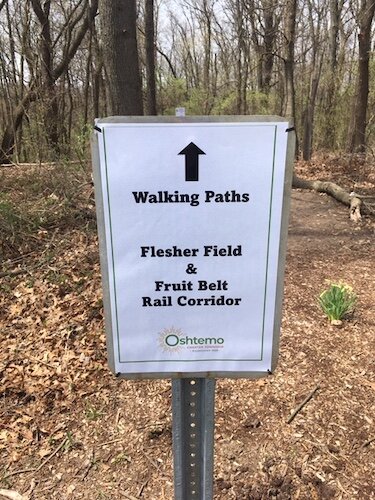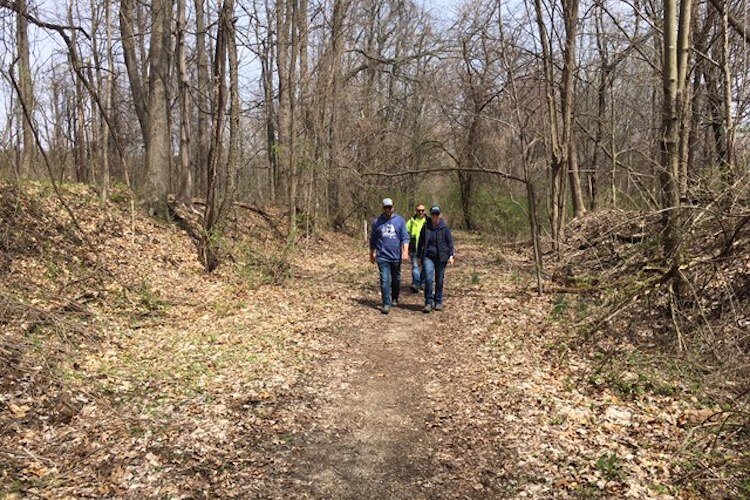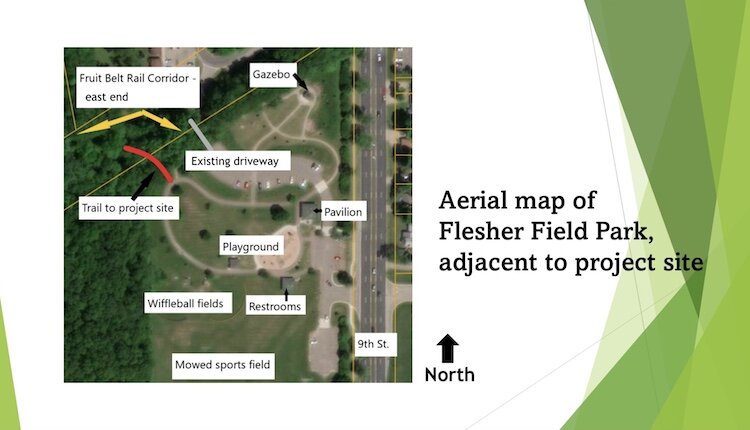Grant award jumpstarts new trail development in Oshtemo Township
A two-mile section of the historic Fruit Belt Rail Corridor was added to Oshtemo Township’s park properties last fall and a new grant award will allow it to begin to be readied for use this summer.
When Oshtemo Township officials surveyed residents about what kinds of recreational activities they’d like more of, places to “take a walk” ranked as a top priority.
Their wish has been granted, with a two-mile section of the historic Fruit Belt Rail Corridor added to the Township’s park properties last fall, and a new grant award that will allow it to begin to be readied for use this summer.
Oshtemo Township’s plan to restore the ecological health of the former rail corridor got a jump start with the recent award of a $150,000 Planet Award grant from Consumers Energy Foundation. Kalamazoo Nature Center’s Conservation Stewardship team, a partner on the project, will provide most of the ecological restoration activities as well as the hands-on environmental education and stewardship opportunities the grant also funds.
It’s a great walking path now, and, someday in the future, the trail may lay the groundwork for a hiking and biking trail that extends all the way to South Haven.
A little history and context
More than 100 years ago that route was cleared to lay the rails for the Kalamazoo, LakeShore & Chicago Railway, known as the Fruit Belt Line. The railroad operated in the early 1900s, with a line from Kalamazoo to South Haven that stopped at a handful of little towns in between.
The line closed in 1924, the were tracks removed the following year, and today the portion of the old rail bed between Oshtemo and Mattawan is used for underground telecommunication lines and an informal walking trail.
Oshtemo Township purchased a section of the former rail corridor property from AT&T in November 2021 with another grant, this one from the Michigan Natural Resources Trust Fund. A condition of that grant is that the land be dedicated to public recreation and natural resource protection in perpetuity.

The 35-acre site is 150 feet wide and two miles long; the hope is that it will eventually be a short section of a regional trail.
“Acquiring this property was a high priority for us,” says Oshtemo Township Parks Director Karen High, “in part because it was already being used as a trail by neighbors and people who were aware of its existence.”
The township’s other walking trails are located in Oshtemo Township Park and Flesher Field. The Kal-Haven Trailhead on 10th Street is in Oshtemo Township and the KRVT connects to the 10th Street trailhead from the east.
“Plus we are fortunate to have the Kalamazoo College’s Lillian Anderson Arboretum and Southwest Michigan Land Conservancy’s Wolf Tree Nature Trails in Oshtemo Township,” High says.
Good now, about to get better
When Kalamazoo Nature Center’s Ecological Services Director, Anna Kornoelje, surveyed the proposed Fruit Belt Trail in the spring of 2020 she found nest cavities of woodpeckers, fox dens and scat, chipmunk burrows, coyote scat, and deer and rabbit fur, all of which indicate a thriving population of commonly found wildlife in southern Michigan.

Earlier surveys in the area suggest birdwatchers may see such species as Downy Woodpecker, Blue Jay, American Crow, Black-capped Chickadee, American Goldfinch, American Robin, Northern Cardinal, and Eastern Tufted Titmouse.
Other widespread summer residents include species such as the Gray Catbird, Red-eyed Vireo, Ovenbird, Scarlet Tanager, Rose-breasted Grosbeak, Indigo Bunting, Eastern Towhee, Baltimore Oriole, and Brown-headed Cowbird. Wood Thrush, Hooded Warbler, and Blue-winged Warbler were also found in the area.
The path winds up and down hills planted with native grasses through forested areas that host a diverse mix of trees — oak, cherry, elm, hickory, beech, birch, various conifers, and maple, some of them likely hundreds of years old.

Ecological restoration work, the first step in converting the current footpath to an accessible trail, will begin this summer with a new survey to identify and assess plant species, followed by invasive species management and native planting.
“I expect it to start with cutting down dead trees and woody invasive vegetation such as honeysuckle bushes,” High says. “We’ll know more when the survey is finished and a work plan is developed.”
The project is expected to be completed at the end of 2023 as a fully accessible trail with parking and a crushed stone surface suitable for hiking or biking. The project site extends from 9th Street to Oshtemo Township’s southern border with Texas Township and abuts Oshtemo’s Flesher Field Park at 3664 South 9th Street.
For now, temporary directional signs mark the entrance at the north end of Flesher Field to guide visitors to the walking path and they can enjoy hiking, birding, or dog-walking.
There is currently no other public access to the site, High says.
Although the corridor is open to the public now, “we haven’t promoted it yet because we need to add stop signs at the road crossing,” High says.
Oshtemo Township Supervisor Libby Heiny-Cogswell says the new grant funds “will allow us to expeditiously make a significant and positive impact on the wildlife habitat in this corridor that we otherwise could not have done. We’re excited to be able to invite the community to participate in the restoration and learn more about the importance of native plants and climate resilience.”
About the Planet Award
The Planet Award grant was one of three announced by Consumers Energy Foundation on April 25, 2022.
The grant’s aim is to preserve, restore, and protect Michigan’s natural resources.
“Consumers Energy is committed to ensuring Michigan has world-class natural resources. Our Planet Awards represent that commitment in action,” says Brandon Hofmeister, president of the Consumers Energy Foundation. “We’re excited to support these projects and confident they will significantly help preserve Michigan’s natural beauty.”
This year’s other two recipients were Macomb County, which was awarded $250,000 to enhance the county’s urban tree canopy and plant 1,000 trees, 1,500 native shrubs, and 40 acres of pollinator habitat on public land, and Brighton, awarded $100,000 to restore the forested wetland and floodplain habitats that make up the headwater area of the Huron River.

















